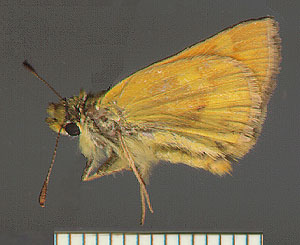
BUG OF THE MONTH: August 1995
Woodland Skipper Butterfly
Order Lepidoptera, family Hesperiidae
Ochlodes sylvanoides
Copyright © 1995 by Louise Kulzer
This article originally appeared in Scarabogram, August 1995, New Series No. 184, pp. 3-4.
 |
| Ochlodes sylvanoides with 15 mm scale |
Some bugs are seasonal alarm clocks. Adults emerge and become active very close to the same calendar date year after year. The woodland skipper is one of these alarm clock bugs, and it's set to go off in early August, at least in the Seattle Area. One day they're everywhere - the day before, you could swear that none at all were around.
In general, skippers are interesting in that they exhibit some moth-like traits and some butterfly-like traits. Like moths, they have stocky, hairy bodies. Like butterflies, they have "knobs" at the ends of their antennae (although a recurved filament protrudes). And they hold their wings simultaneously flat as do moths (the hind wings) and folded up over the body as do butterflies (the fore-wings). Bob Pyle (1981) likens this schizophrenic posture to a folded paper airplane.

|
|
Male & female dorsal patterns |
That is a good descriptor for the woodland skippers for another reason as well - their flight is also more like a paper airplane than a butterfly. They have a swirling, looping flight, accentuated when a group of them gets together! Coupled with their tawny orange color, they remind me more of falling leaves or blossoms than of insects. But engaging black eyes peering from the base of their spiky orange hair shocks remind me of my error.
Woodland skippers lay small ivory eggs which hatch into sleek green caterpillars. The caterpillars have a narrower segment between the head and the rest of the body - a "neck" if you will. They feed on grass. Yes, grass. One reason, no doubt, for their abundance. But I defy you to find even one of these invisible caterpillars, for they feed at night and hide by day in shelters of leaves stitched together with silk (Christiansen, 1981).
 Adults are rewarding to have in the garden since they are not picky, like some
butterflies I could mention, about what they nectar on. They have been recorded
on buddleia, the queen of nectar plants, as well as on lobelia, zinnia, lavender,
dandelion, mint, coreopsis and statice, to name a few (Butterfly Gardening Study
Group, unpublished notes).
Adults are rewarding to have in the garden since they are not picky, like some
butterflies I could mention, about what they nectar on. They have been recorded
on buddleia, the queen of nectar plants, as well as on lobelia, zinnia, lavender,
dandelion, mint, coreopsis and statice, to name a few (Butterfly Gardening Study
Group, unpublished notes).
Keep an eye out for this easy-going denizen of the garden. Maybe the Scarabs can vote whether its flight reminds us most of a) paper airplanes, b) falling leaves, c) cherry petals, or d) e) f) your ideas (that is, if it ever stops raining long enough for them to fly).
References:
Christensen, James R. 1981. A field guide to the butterflies of the Pacific Northwest. Northwest Naturalist Books, University Press of Idaho.
Pyle, Robert M. 1981. The Audubon Society field guide to North American butterflies. Alfred A. Knopf, New York.
This page last updated 16 June, 2005